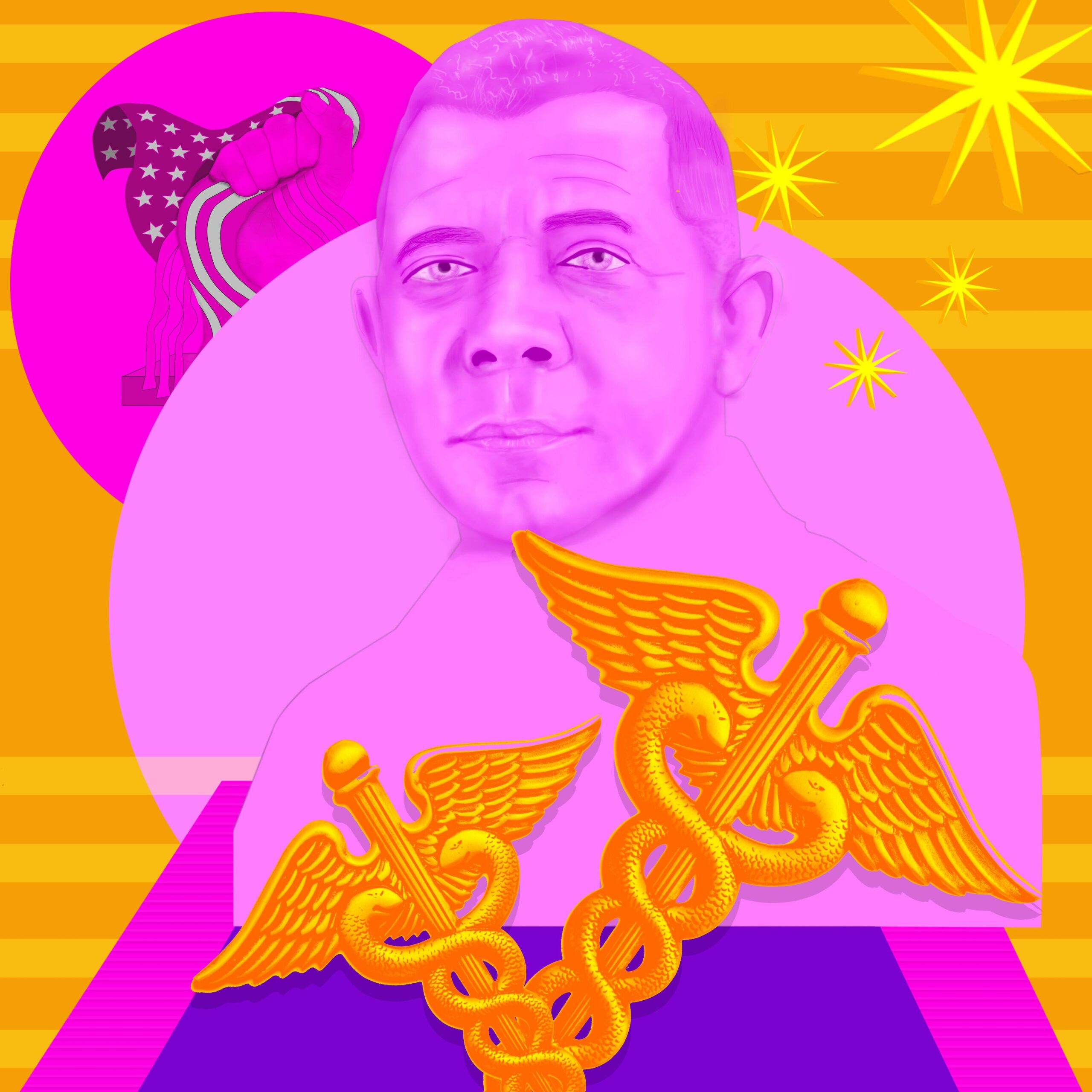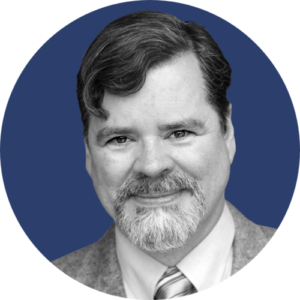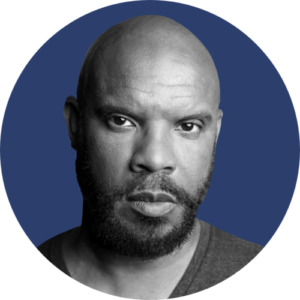
Attendees of the 1914 “Fifty Years of Negro Health Improvement in Preparation for Efficiency” conference, with speakers including Booker T. Washington, heard staggering information about the Black population’s “health”, which was in crisis. Life expectancy for African Americans at the time was about 35 years.
African Americans rallied public health professionals to confront disease. They understood how poor health outcomes endangered their collective destiny and compromised their ability to fight for full equality. They knew that illness, disease, and lack of means and systems to treat them compromised freedom.
Clean communities could improve living conditions. But clean living couldn’t undo the harm or violence of the Jim Crow era that was gradually becoming systematized in law and society.
View Transcript
Kidada E. Williams: In 1914, Black academics and intellectuals traveled to central Alabama for a conference to discuss the state of Black America, as they saw it. Some hit US highway 80 from Montgomery, 38 miles to the west. Others made the 125 mile sojourn from Atlanta on what was highway 29. Their final destination: the pristine campus of Tuskegee Institute, the state vocational school.
The conference’s theme was “Fifty Years of Negro Health Improvement in Preparation for Efficiency” and speakers included Tuskegee’s leader, Booker T. Washington. Attendees heard staggering information about the Black population’s “health” and it was in crisis.
Booker T. Washington: 45% of all deaths among Negroes [are] preventable; there are 450,000 Negroes seriously ill all the time…The following are diseases most fatal to Negroes: diseases of infancy, from which 25% of all deaths among Negroes occur; Tuberculosis, from which 18% of all Negroes die; pneumonia, 11% of all their death…
[list continues, fading out behind narration]
KEW: Life expectancy for African Americans at the time was about 35 years. Medical experts projected that they could extend that age to 50 by 1963, but only with the country’s commitment to widespread changes in the living conditions that made Black people more susceptible to preventable disease.
BTW: Diseases exact their greatest toll from the young; the diseases which annually sweep away large numbers of our people exact their greatest toll of babies and children and of our young men and women, who being in the very prime of life, constitute, economically and intellectually, a most valuable asset for the future progress of our race. Instead of these persons living and doing service as leaders of the masses of our people, they give their lives a useless toll to death.
KEW: Jim Crow, lynching, and disfranchisment intensified Black people’s impoverishment—whether they were in the factory-filled cities of the Northeast, Mid and Far West, or scattered across the rural South working as tenant farmers.
Great Migrations to the urban North and West initially eased some of the struggles. But as segregation forced migrants into desperately cramped, subpar housing in smoggy, grimy destination cities, health issues soon followed. Racist policies created conditions that allowed diseases—like hookworm, tuberculosis, malaria, typhoid and venereal disease—and high maternal and infant mortality to thrive. And the futures Black people tried to secure by migrating were at risk.
BTW: We must reduce our high death rate, dethrone disease and enthrone health and long life. Let’s make a strong, long, united pull together. The future of the race depends upon the conservation of its health.
KEW: This is Seizing Freedom. On today’s episode: How African Americans in and around Tuskegee rallied public health professionals to confront disease and illness to seize health and freedom for communities across the nation.
Now, some of you might be thinking, “Oh. An episode on Tuskegee and health. I know where this is going and it’s not good.” But these efforts to address racial disparities in public health started decades before the idea of medicine at Tuskegee became synonymous with the U.S. Public Health Service’s unethical and abusive syphilis study. We’re gonna get to those. But first, we’re going back.
Even during their enslavement and during the Civil War, Black people seized as much control over their health and treatment as possible. When slavery ended, having adequate access to care and treatment was critical to their goals for self-determination. So they rushed to the fore—as doctors, nurses, healers, midwives, informed patients—and assumed responsibility for individual and communal health. They fought racist treatment in their demand for access.
BTW: Our only remedy for this fearful drain on the pick and flower of our young womanhood and manhood is a widespread inculcation of the habit of clean surroundings and clean living.
KEW: Washington had long known the potential positive impact sanitary science and preventative medicine might have on improving Black Americans’ health outcomes—especially in the rural South.
Back in 1906, before technological advancements provided for a truck, Tuskegee established the Moveable School—a dressed up, mule-drawn wagon. It traveled across Alabama, starting at home in Macon County and spiraling out across the state. At first, the mobile unit carried experts on agriculture and social work, committed to bringing uplift to tenant farming families in need.
Thomas Monroe Campbell: To say that we were alarmed at many situations in which we found ourselves is putting it mildly.
KEW: Thomas Monroe Campbell was a student of scientist George Washington Carver and a Tuskegee graduate. Washington and Carver convinced the USDA to hire him as an extension agent, delivering instruction on crop diversification, procedures for procuring and maintaining clean milk, and home improvement. Campbell’s first job was managing Tuskegee’s Movable School unit.
TMC: …the system of tenancy, or living from hand-to-mouth, has taken a hold of the people to such an extent that it affects the whole life in psychology of the average Negro community.
KEW: The Moveable School team’s home and plantation visits offered updated farming and cleaning demonstrations; they built outdoor sanitary toilets and put screens on windows to keep homes ventilated. Their work put them on the front lines of the distressing health crises plaguing tenant farmers in Alabama’s Black Belt.
TMC: The ignorant rural Negro often allows his home to become or remain a run-down shack, around which health conditions become so terrible at the way it paves for the most ravaging disease. As a result he is obliged to pay excessive doctor bills, and experiences a high mortality rate among the members of his family. It is through these and many other similar deplorable conditions that the Movable School attempts to work its way to the bottom of the rural Negro’s problem.
KEW: The ongoing betrayals of Reconstruction had given Black tenant farmers and sharecroppers a well-earned distrust of white Alabamans and federal officials. Campbell needed someone in whom they could put their confidence.
He convinced Tuskegee and the Alabama State Health Department to hire a rural public health nurse, at $100/month—with a $50 travel allotment—so she could accompany the extension team, scope out unsafe conditions, and provide medical guidance.
TMC: The truth of the matter is, we seriously considered abandoning the practice of going to the homes because of the constant danger and exposure of our workers to diseases and unsanitary conditions which we found in these homes. Being, however, so thoroughly conversant with the standard of living and so recently emerged from a similar atmosphere, I felt confident that these people were susceptible to the same practical teachings we were taking to them.
KEW: He found a distinguished Tuskegee alumna, Miss Uva Mae Hester, who fit the bill. Nurse Hester’s job was to deliver health education in the form of: medical literature, instructions for midwives on healthy deliveries, encouraging healthy foods, and urging families toward clean homes.
Uva Mae Hester: Wednesday: Left boarding place at 8 a.m. While waiting for a buggy, we visited two homes. The first family consisted of a mother and six children living in a very dirty two room hut. The oldest child, a girl of nine years, had suffered from infantile paralysis and was left lame as a result. The baby was suffering from diarrhea and had a peculiar rash on its body. The other child is apparently well, but extremely dirty. I suggested bath and a way of ridding the house of flies, also a suitable diet for the baby.
KEW: As a Black woman, she wasn’t allowed to provide care. But she couldn’t just leave what she saw; the conditions were so bad.
UMH: I visited two communities today. The first home was in a splendid location, but its two rooms were entirely too small for the 12 people that made up the family. The second home had two rooms. There were three in this family, the mother, stepfather and a 17 year-old daughter who had undergone an operation for abscesses on the chest and side. She had been in a hospital. I found her lying on the bed of wheat straw, too filthy for description. There was a profuse discharge of pus from the dress wounds and the flies swarm over her in such numbers that I can hardly see her face.
With a branch as a fan she was making a feeble attempt to keep them off. At my suggestion, we made an old cot on the little porch as comfortable as possible and placed her on it. I gave her a bath and in doing so found that she had a pressure sore the size of my hand on the sacral region of her back, from which her backbone protruded. I dressed the wound with material from my first aid bag.
The girl with tears in her eyes thanked me and said that if she were able to get to her grandmother’s she would give me a pig for the little help I rendered. Wishing her much comfort I said goodbye.
KEW: Hester faithfully carried out her duties, evident in glowing assessments of her performance. And the Moveable School continued in this way for decades. It recruited new nurses, like Eunice Rivers, straight out of school at Tuskegee.
In an interview recorded in 1977, Nurse Rivers recalled that most of her efforts with the Moveable School centered around maternal and infant care.
Eunice Rivers: All of this was my responsibility. Teaching the midwives how to deliver, how to wash their hands, cut their nails and how to deliver, how to make the pads, how to prepare the bed for the delivery, because at that time most of the women had the babies on the floor. We had an awful time trying to train the mothers to use the bed instead of on the floor. We took paper—and there was no such thing as a draw sheet, a rubber sheet—so we carried old newspapers all the time, on the truck and clean rags and this kind of thing, trying to teach the people how to do this.
KEW: Thomas Monroe Campbell commended his mobile team’s work, which became a model for other states, and even some communities in India. But he also noted the impossible conditions they found Alabama tenant families living in.
TMC: Possibly the most neglected phase of public service today among them is sanitation and simple health instruction. Negro farmers are not likely to give much attention to hogs stricken with cholera, nor to weevil-infested cotton, when their families are suffering from tuberculosis, typhoid, malaria and hookworm disease. The squalor, filth, disease and dilapidation of their surroundings reflect not only upon them, but upon the whole South; in this condition constitutes not only a Negro problem, nor a southern problem, but a national one.
KEW: To expand on the success of the Moveable School, more national campaigns—bolstered by the federal government, and coordinated with local and state government public health officials—were needed.
BTW: Without health, and until we reduce the high death rate, it will be impossible for us to have permanent success in business, and property getting, and acquiring education, or to show other evidence of progress. Without health and long life all else fails!
KEW: While the Moveable School was out in the field—doing its best to address the urgent needs of rural folks—another public health campaign emerged. So, in 1914, while speaking to attendees at the conference discussing Black Health Improvement—as the powerful head of Tuskegee and president of the National Negro Business League—Booker T. Washington shared his vision.
Though he had long lost favor with some of his more progressive Black peers, Washington still helmed the Tuskegee Machine: the vast network of conservative Black newspapers, loyal activists and political organizations, white patrons and media influence, to advance reform.
Washington was also beloved by rural and working-class Black folks eager for land ownership—whom he visited often to deliver advice.
Mary Simpson: I always tried to follow the advice of Booker T. Washington. I would never take up all my credit at the store.
KEW: People like Mrs. Mary Simpson or Mr. O.C. Crowe—both out of Alabama—thought Washington’s word on the importance of Black economic self-determination was gospel.
O.C. Crowe: I used to hear doctor Washington speak about ‘owning your home’ and ‘living at home.’ …[So] I borrowed $200 to make the down payment on 6 acres, a house, a store and a barn. I sold hogs that year and made the payment. After I finished paying for this, I was able to buy 30 acres more, which I paid for in the same way. Two years later, I bought 5 1/2 acres and made all the payments with money from the sale of pigs and cattle.
KEW: Knowing he still had a strong base of support in the Simpsons and Crowes of the nation, Washington called on all Black Americans to unite under the banner of their own urgent public health needs. In the spring of 1915, he issued a press release that was published in Black and white papers across the country.
BTW: I have thought it advisable to ask the Negro people of the whole country to join in a movement which shall be known as Health Improvement Week, beginning April 11th to April 17th, 1915. They can be taught what to do to aid in improving their health conditions. Thus the amount of sickness among us can be lessened and the number of deaths annually decreased…In carrying out suggestions, they will be doing the best possible service to themselves and to the race.
KEW: Washington’s campaign, which would eventually become National Negro Health Week, had two goals. First: to provide practical suggestions for local health organizations. And second: to encourage people to be heavily involved in the clean up, educational hygiene, and sanitation of their own homes and communities.
Setting aside an entire week each spring—generally around the same time so that the nation could have a sense of camaraderie—Washington’s oversight committee sent out the following instructions for “what to do during cleanup week:”
Oversight Committee Member 1: Move out and burn up all unnecessary rubbish and all unused old clothing and waste.
Oversight Committee Member 2: Move, dust and clean well all pictures, furniture, drapery, carpeting, bedding, clothing, cooking utensils and all household wares.
Oversight Committee Member 3: As far as possible, take all the furnishings of the house into the open air and sun them all day. If the day set aside for cleaning up is cloudy or rainy, do this on the next bright day.
OCM 1: Brush down the walls and ceilings of all rooms, scrubbing clean thoroughly all the floors and woodwork of the house.
OCM 2: In scrubbing the floors, use strong lye in hot water; And cleaning furniture and painted woodwork, use warm water in good soap.
OCM 3: Do not use lye on anything that is painted.
OCM 1: Paint or whitewash the walls, sealing in woodwork. Then thoroughly dry, and sun every room, especially the bedrooms.
OCM 2: Give careful attention to the front and back yards, and under the houses, as these menace the health and comfort of your family as long as they remain untidy. Scrape off the worn surface dirt, level the walkways and paint or whitewash the fences and house.
OCM 3: Repair the stable, the barn and hen house. White wash them if you can and see that no filth remains in which flies can breathe.
OCM 1: Look after the springs and wells, and make sanitary the outhouses at school houses and churches.
KEW: Washington and his committee asked Black health activists to circulate the program in their communities, to cast a wide net for extensive buy-in.
BTW: It is hoped that the schools, churches, secret societies, business leagues and other organizations…namely: daily and weekly newspapers, health journals, the National Medical Association, Colored insurance companies, farmers conferences, farmers improvement societies…will take the lead in seeing that health committees are organized for the purpose of cooperating in this movement to secure better health for our people.
It is hoped that these committees, when organized, will endeavour to get the health officers of states, cities and counties to cooperate with them to make the health week observance effective.
KEW: But, how much clean living—as opposed to access to good healthcare—could actually improve disparate health outcomes was questionable. It was a point raised by Black doctors, with whom Washington and his team did not appear to consult.
Black doctors could have led a charge in community-wide programming to provide health education, but didn’t. They were fighting their own battles against their racist peers, and they were vastly outnumbered. They couldn’t wield the same political capital to launch a national health campaign as Washington could. Likely afraid to undermine the movement (and invoke the Wizard’s wrath), Black critics voiced their concerns quietly.
Since there were so few doctors or hospitals providing Black people with adequate care—especially the poor—Washington placed his belief in Black self-determination. His idea was that laypeople—trusted local church leaders, elected officials, and journalists—wielded more influence to change thinking and behavior in ways that would improve health than medical professionals could.
Washington admitted that his idea wasn’t an entirely new one:
BTW: In Alabama, Louisiana, North Carolina, and other states special health days have at one time or another been observed…
KEW: …Though he wanted to expand from separate, local efforts to a national campaign. Black women in particular had been, and continued to be a public health force for their communities—led by activists like Mary Church Terrell, president of the National Association of Colored Women.
Mary Church Terrell: Feeling the great responsibility resting upon them, Colored women are working with might and main to afford their unfortunate sisters opportunities of civilization and education, which without them, they would be unable to secure.
KEW: But Black women hadn’t been invited to Booker T. Washington’s conference. Margaret Murray Washington chafed at her husband’s exclusion of women. She organized the Tuskegee Woman’s Club—made up of the wives of male teachers—who could take the lead in providing uplift for people in the larger Macon County community.
Margaret Murray Washington: The people themselves are most responsive and cooperative, and as a result of the work which has been done along these lines, great improvements have been made.
MCT: Under the direction of Tuskegee, the work of bringing the light of knowledge and the gospel of cleanliness to their benighted sisters on the plantations has been conducted with signal success. By the Tuskegee club and many others all over the country, object lessons are given in the best way to sweep, dust, cook, wash and iron—together with other information concerning household affairs.
Talks on social purity and the proper method of rearing children are made for the benefit of those mothers, who in many instances fall short of their duty, not because they are vicious and depraved, but because they are ignorant and poor.
KEW: But how receptive and tolerant poor and working-class Alabamans were of the elite Woman’s Club’s members is a matter of debate. Women’s social clubs always involved genuine interest in helping the less fortunate, whose lives and living conditions they assessed with rigorous detail. But often, that charity was tempered by a healthy dose of harsh—sometimes cruel—judgements.
Health activists concentrated their efforts on the environments in which families lived—large, sometimes multiple families living in a single dwelling that gave under years of strained use and limited resources for improvement—and what they saw as the specter of impropriety, “promiscuity and dissipation.” Which makes sense: poor living conditions lead to health disparities.
MCT: Homes, more homes, better homes, purer homes is the text upon which our sermons have been and will be preached.
KEW: But Mary Church Terrell and her contemporaries wagged their fingers at Black women who lived in those conditions instead of at the conditions themselves.
MCT: …information in everything pertaining to the home will be disseminated. We would have heart-to-heart talks with our women, that we may strike at the root of evils, many of which lie, alas, at the fireside.
KEW: Affluent activists showed their privilege by suggesting that Black people’s health and living struggles would ease if poor people simply adopted the values and ways of the well-to-do, and just stopped being poor.
Clean communities could improve living conditions. But clean living couldn’t undo the harm or violence of the Jim Crow era that was gradually becoming systematized in law and society. But Washington’s call for a nationwide health campaign was enough to spark a coordinated movement. In August 1915, he hailed the first observance of Health Improvement Week as a success.
BTW: It was gratifying to learn how widely Health Week was observed throughout the country…in short, changing all those conditions about the home which have a tendency to promote disease. This is one of the practical ways in which we are endeavoring to reach the masses of our people and raise their ideals of living among them.
KEW: It would be his last public address. The Wizard of Tuskegee—who twenty years earlier captivated a nation with his amassing of political and economic power—was likely suffering from headaches, fatigue, weight loss, and failing vision. High blood pressure had compromised his kidneys. He died three months later, never seeing the movement mobilize more people to action.
In 1921, Robert Moton—who had assumed Tuskegee’s presidency after Washington’s death and continued the Health Week Movement—wrote to the U.S. Surgeon General. He wanted the United States Public Health Service’s help with promotion.
Recognizing the campaign’s potential for advancing its own mission, the Public Health Service agreed to bolster the campaign and its capacity to bring the movement to the people. The Service inaugurated and hosted the annual National Negro Health Week conference and took over publication of the Negro Health Week Bulletin, rapidly expanding the scope of each. They increased local observances, as federal initiatives tend to do.
The Atlanta Urban League’s Jesse Thomas lauded the support, saying:
Jesse O. Thomas: …that the federal government has adopted the health week as its own project is an unmistakable testimony that the government has recognized the beneficial results that have come from the activities of this organization…and it is disposed to assume a larger share of its responsibility in connection with the help of its frequently forgotten 10% of our population.
KEW: The Service provided much more specific and medically-driven guidance. The Bulletin included articles encouraging people to get the latest vaccinations and do annual health care screenings. One article recognized individuals’ obligations to the public health that might seem familiar in light of the most recent global pandemic:
US Public Health Service Rep: Keeping well is a practical ideal, but it requires some attention and effort. There are some things which the individual can do on his own initiative and with his own individual resources, while there are other things which he must attend to in common with others.
Cooperation with these health authorities is the mark of neighborliness and community helpfulness. Without this willingness to permit the health of the community to take precedence over individual convenience, it would not be possible for a man to live in the intimate and common relationships of civilized Community Life.
KEW: In the 1930s, health movement activists blanketed communities with posters and brochures drawing attention to the campaign’s annual theme. Black newspapers were full of editorials, announcements, photographs of activities, health-centered coverage and deep investigative dives. With the advent of home radios, the movement hit the airwaves.
For the 1929 observance, the National Negro Health Week Bulletin ran an ad with advice for “How to live a 100 Years: A Practical Program of Health Habits.”
Bulletin: Breathe fresh air, both day and night. Exercise your larger muscles regularly every day. Take at least 8 hours of sleep. The voice of wisdom says one should turn off the radio at 10. Drink plenty of water at meals and also between meals. Eat temperately, partaking of vegetables and fruit for “roughage” and health’s sake, and sparingly of meat and sugar. Have regular bowel habits. Avoid infection from both outside and inside sources. Wash your hands before eating. That the teeth are to be cleaned night and morning is taken for granted. Think wholesome thoughts. Face unpleasant situations frankly and sensibly, and don’t worry. Keep your play spirit.
KEW: The 1930 National Negro Health Week Bulletin included a picture of Black doctors examining Black patients, young and old, and advised people to go to their family physician for a health exam once a year because he “lives along with you.”
By 1941, upwards of 4 million Black Americans were participating in observances across the country. Thanks to a combination of advancements in public health education, sanitation, medicine, and municipal services, their life expectancy had increased significantly—for Black men to about 57.5 years, and for Black women to almost 63 years.
Some Black physicians and professionals lauded the progress but were disquieted by maintaining a separate health campaign amid the rising movement demanding desegregation in all areas of life. An article in The Pittsburgh American worried that “a Jim Crow Health Week is an admission of physical inferiority and mental weakness on our part.”
Reflecting the Public Health Service’s professed commitment to integrating its programming, a white, male North Carolina health official said:
NC Health Official: We have no desire or intention to single out the problem of the Negro for a special discussion, because one of our cardinal principles in this office for nearly a quarter of a century has been that we regard the Negro and his problems identical with the white man and his problems…Negroes need the same kind of treatment when they are sick that the white man needs.
KEW: The USPHS shut down the Black observances of Health Week, in 1951. Black health programs and providers best positioned to maintain Black public health were folded into white-controlled organizations, and a health program for all Americans. Neither was invested in addressing the realities of racial health disparities, which allowed them to rebound.
Activists in Booker T. Washington’s National Negro Health Movement understood how poor health outcomes endangered their collective destiny and compromised their ability to fight for full equality.
They understood the nexus of health and freedom, as well as the importance of public health initiatives’ capacity to protect and improve the lives of people and the health of their communities.
They knew that illness, disease and lack of means and systems to treat them, compromised freedom. Healthy foods, homes, bodies, babies, seniors, differently abled peoples, families, communities and environments were—and remain—freedom issues.
But supporting the Health Movement wasn’t all the USPHS was up to. For forty years—from 1932 to 1972—the Public Service conducted what they called the “Study of Untreated Syphilis in the Negro Male” in Macon County, Alabama, under the auspices of the Tuskegee Institute.
The USPHS wanted to find out what happens when syphilis goes untreated. Tuskegee’s leaders hoped to get credit for a successful study, that their students and medical professionals would benefit, and that the school would get more funding.
623 men—who were Black farmers, sharecroppers, and day laborers seizing their freedom and charting their and their families’ destinies—were enrolled in the study, which was originally designed to run for six to twelve months. Some (about ⅔) already had syphilis, including from birth. Others didn’t.
After working at the Movable School for almost a decade, Eunice Rivers took a job as a nurse on the syphilis study.
Eunice Rivers: I got with this syphilitic program. It was sort of a hoodwink thing, I suppose. Not hoodwink, I don’t mean it like that. But at that particular time, Macon County was overrun with syphilis and gonorrhea. In fact, the rate of syphilis in the Negro was very, very high. Something like 88% or something like this.
KEW: Black Alabamans in the community surrounding Tuskegee’s campus had welcomed the Movable School. They saw the benefits of the medical care provided by nurses like Uva Mae Hester and Eunice Rivers, and by medical professionals at the Institute’s hospital and community health clinics. These initiatives, and the Black nurses’ respectful treatment of their Black patients, engendered trust.
In a 1990 documentary by the BBC, Carter Howard recalled meeting Nurse Rivers:
Carter Howard: She was very nice and friendly and we had a lot of fun. She was very nice.
Interviewer: Did you trust her?
CH: Trust? Yeah, I had a lot of confidence in her. Sure did.
KEW: Men like Howard thought they were participating in general clinics—the same as Tuskegee had been running for more than a decade, which included vaccinations for typhoid, diphtheria, and smallpox.
The recruitment campaign was aggressive, and deceptive; they didn’t announce that they were studying syphilis. Instead, participants were promised medical care for “bad blood,” an umbrella phrase for a variety of ailments—including syphilis—which many of the men didn’t know they had. The PHS doctors and nurses knew, but never disclosed or provided treatment.
The study’s participants were promised free food on testing days. And free medicine, recalled Herman Shaw.
Herman Shaw: Well, you couldn’t buy medicine. You couldn’t get a doctor. You get free medicine. That’s what we signed up to get: free medicine that wouldn’t cost you anything. And they gave everybody…the thing about it is, I should have woke up before I did…everybody didn’t have the same complaint. But they got the same medicine, same liquid, and the same pill, the same capsule.
Eunice Rivers: We knew and all the doctors knew in this area that these people were not supposed to have gotten any treatment. Now the doctors would have…maybe the patient was complaining of something else. They always had little packets in their car, in their bags, that they would give this patient, you know?
Interviewer: Well now, they always gave out that pink medicine, didn’t they?
ER: Ooh, they just loved that pink medicine.
Interviewer: Pink medicine was pink aspirin.
ER: Yes.
Interviewer: To help with everyday pains.
ER: Everyday pains, this is true.
KEW: But men like Herman were never told about the true purpose of the study.
HS: So then those people that died, those patients that died, they started dying…[unintelligible] A man by the name of Mark Yarbrough died up there, and then they started…I could name any number of them that started dying then. Anders went, Buttress went…oh, any number of them.
And then my daddy-in-law was in it. And I’m trying to think the year he died. But they gave the family $35 on his burial. That’s the first time we’d known anything about $35.
KEW: After the planned year of the study was over, the lead scientist decided to extend the study to conclude only when the participants were dead. Doctors were fascinated by the disease and needed autopsies to support their emerging theories.
Eunice Rivers: And I recall one man—I’ve forgotten what his name is now—but he had all of his chest…one side eroded; that’s what the doctors told me it was. He had these attacks quite often and I’d go run and bring him in. And they told me in one of the studies, “Don’t let him die at home! Bring him in so we can open him up and see.” And he lived about two years with this thing.
KEW: By 1947, syphilis was incredibly treatable with penicillin. But none of the Black test subjects received it from the study’s nurses or doctors; they were asked not to take it or removed from treatment queues (though some found a way, anyway).
The Public Health Services’ syphilis study wasn’t a secret. Medical professionals, including Black doctors, knew. Dr. Paul B. Cornely, of Howard University, taught about the study in his classes while it was in progress.
Dr. Paul B. Cornely: …and I didn’t say a word. I saw it as an academician. It shows how we looked at human beings, especially Blacks, who were expendable. I have guilty feelings about it, as I view it now, because I considered myself to be an activist. I used to get hot and bothered about injustice and inequity, yet here right under my nose something is happening and I’m blind.
KEW: By the time the study was shut down in 1972, at least a third of the Black men with syphilis had died from complications. The administrators’ fixation on waiting for and studying the men’s autopsies resulted in atrocious record keeping, so it’s hard to get specific data on the collateral damage to the men’s families. But we know that at least 22 of the men’s wives contracted syphilis, and 17 children and 2 grandchildren were born with it as a result of the US Public Health Service’s withholding treatment.
Herman Shaw: Nobody knew what we was being treated for. I was with it from start to finish. I lived through it, thank God. And I never missed an appointment, never missed a date. I really don’t know what made them do it. I just assumed they did it because they were in authority and they had the power to do what they did.
KEW: Biographers have said that Nurse Rivers was neither a victim nor a villain. Rivers acted in her own personal interest as a striving Black woman in the South during Jim Crow, and as a nurse invested in what government attention might bring to her community’s public health.
In 1997, Herman Shaw was invited to the White House—the week before his 95th birthday—for a formal apology issued by President Clinton to the Public Health Service’s study’s subjects.
Herman Shaw: It has been over 65 years since we entered the program. We are delighted today to close this very tragic and painful chapter in our lives. We were treated unfairly, to some extent like guinea pigs. We were not pigs. We were all hard-working men, and not boys, and citizens of the United States. The wounds—the wounds, rather—that were inflicted upon us cannot be undone. I’m saddened today to think of those who did not survive and whose families will forever live with the knowledge that their death and suffering was preventable.
KEW: The collective damage in trust as a result of the PHS’s study at Tuskegee has been catastrophic. It undermined the health education campaigns of the early 20th century and still compromises public health and our efforts to confront disease today.
Herman Shaw: In my opinion, it is never too late to work to restore faith and trust. In order for America to reach its full potential, we must truly be one America, trusting each other, caring for each other, and never allowing the kind of tragedy which has happened to us in the Tuskegee study to ever happen again.
KEW: The families of the men who were victimized by the PHS syphilis study have created an organization, Voices For Our Fathers, to preserve the legacies and history of what happened to them and confront misinformation about the study. You can find more about it at: voicesforfathers.org.
Voice Actors

Aaron Goodson
Voice of Dr. Paul B. Cornely

Candice Holley
Voice of Mary Simpson, Margaret Murray Washington

Chiquita Melvin
Voice of Uva Mae Hester

Conrad Haynes
Voice of Thomas Monroe Campbell, Oversight Committee Member 2

Constance Swain
Voice of Mary Church Terrell

Dale Leopold
Voice of U.S. Public Health Service Rep, NC Health Official

Frank Harrison, Jr.
Voice of Jesse O. Thomas

Jefferson A. Russell
Voice of Booker T. Washington, Oversight Committee Member 1

Madyun Shahid
Voice of O.C. Crowe, Oversight Committee Member 3

Ronald Young, Jr.
Voice of Bulletin
Episode Resources
The following resources were utilized in the research and creation of this episode:
- Eula Biss – On Immunity: An Inoculation
- Paul Braf – “Moving from the National Negro Health Week to the National Public Health Week in the US”
- Alan Brandt – “Racism and Research: The Case of the Tuskegee Syphilis Study,” The Hastings Center Report
- Vanessa Northington Gamble – “Under the Shadow of Tuskegee: African Americans and Health Care”
- George Lakoff – Don’t Think of an Elephant: Know Your Values and Frame the Debate
- Michele Mitchell – Righteous Propagation of the Nation: African Americans and the Politics of Racial Destiny
- Cynthia Neverdon-Morton – Afro-American Women of the South
- Sandra Crouse Quinn and Stephen Thomas – “The National Negro Health Week: 1915-1951: A Descriptive Study”
- Susan Reverby – “Rethinking the Tuskegee Syphilis Study: Nurse Rivers, Silence, and the Meaning of Treatment”
- Stephanie Shaw – What a Woman Ought to Be and Do: Black Professional Women Workers during the Jim Crow Era
- Susan L. Smith – “Neither Victim Nor Villain: Nurse Eunice Rivers, the Tuskegee Syphilis Experiment, and Public Health Work”
- Susan L. Smith – Sick and Tired of Being Sick and Tired: Black Women’s Health Activism in America, 1890-1950
- Timothy Snyder – What Ails America
- Tiffany Walker – National Archives: “National Negro Health Week: 1915-1951”
- Harvard Radcliffe Institute, Schlesinger Library – Black Women Oral History Project Interviews
